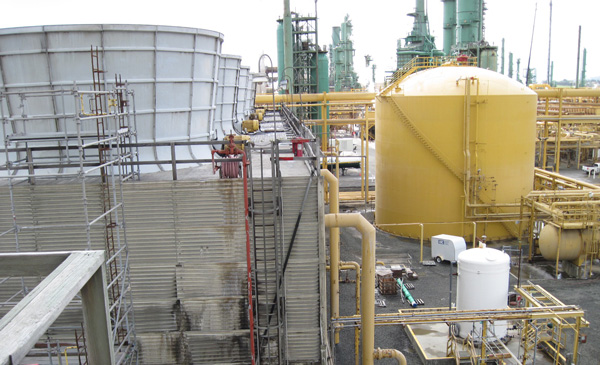10 Energy and Performance Improvements to Make in 2016

Preparing for 2016 cooling tower operations and performance? Start the new year off right and consider these top 10 energy improvements that you can make in 2016 to optimize your cooling tower energy consumption and efficiency all year long.
- WATER QUALITY:
What is the largest makeup of a cooling tower that is imperative to its function? Water! Many focus on parts, structure and mechanics of a cooling tower to improve cooling efficiency, however water management is just as important. Cooling tower energy savings begins with improving your cooling system by managing your water quality. Maintain your water quality and improve energy by keeping water free from debris, dirt, microbes and high salt concentrations which leads to scale, corrosion, and biological fouling that clog nozzles and fill. To maintain water quality, it can be recommended to manage a water treatment plan. Implementing a water treatment plan will help you to identify copper leaching (in wood structures only), as well as develop an implementation strategy for bio-control and corrosion inhibitors.
- WATER USAGE & CONSUMPTION:
The next step is to manage your water consumption. The quality of water will aid in improving water flow rate, which in turn affects your tower's water usage. Complete an analysis of your current water consumption by calculating your water usage. You can use our water calculator tool to do this. Once you understand how much water your tower is using, you can start making adjustments to improve your cooling tower water consumption.
- CONTROLLING TOTAL DISSOLVED SOLIDS (TDS) WITH BLOWDOWN / MAKE-UP:
Cooling tower blow down is important in helping to maintain your plants pre-determined allowable TDS concentrates in your water system. To help control TDS concentrates, clean water or make up must periodically be re-introduced into your cooling system to lower the TDS concentrate. Blowdown is a necessary action to complete and will help maintain water quality and aid in reducing scale build up on parts like nozzles, fill, and DE's. For this reason, blowdown will aid in improving cooling tower performance and efficiency. Learn more about cooling water chemistry and controlling cooling water cycles.
- CONTROLLING WATER TEMPERATURE:
Being able to control your cold water temperature or wet bulb temperature means understanding how to properly control air flow and fan speeds. For example, if your plant needs to maintain a maximum of 70 degree cold water temperature, but the air temperature outside is cooler, then fans can be cycled and the energy output controlled (dependent on what type of gearbox you have) to help save energy.
- UTILIZE VFD'S (VARIABLE FREQUENCY DRIVES):
Variable frequency drives (VFD's) allow for optimal cooling tower performance and energy efficiency. VFD's allow for the best optimal performance because VFD's can run fans at any speed. This allows for specific air control and optimized energy outputs. For example: Especially during extreme hot or cold months, VFD's aid in energy savings by allowing the operator to run each cell at a different speed. This optimizes performance by controlling air flow and leads to significant energy efficiencies.
- CHECK FAN BLADE PITCH:
Checking your fan blade pitch is another energy savings tip. Your fan pitch can help increase the amount of air flow, allowing for increased performance, and less energy usage. Learn how to step by step, check and change fan pitch for your cooling tower.
- CHECK & REPAIR PARTS (NOZZLES, FILL, DRIFT ELIMINATORS):
Ensuring that your cooling tower nozzles, fill, and drift eliminators (DE's) are all repaired and in good working condition is also essential to cooling tower efficiency and performance. Clogged nozzles, fouled fill or broken DE's will inhibit the heat transfer process by affecting the water distribution and efficiency of your cooling tower water usage.
- CLEAN BASIN SCREENS (counterflow):
To remove the risk of debris re-circulating through out your tower and clogging your nozzles or fill, it is important to keep your basin screens clean. To clean your basin screens, you must first pull them out one at a time, usually by crane. Then you can pressure wash the screens (one at a time) to remove the debris preventing further damage and performance issues.
- USE CORRECT WINTER OPERATING PROCEDURES:
By following proper cooling tower winter operating procedures, you can save energy, maintain performance and tower integrity throughout harsh winter months. By minimizing winter damage and performance issues, your tower will be better prepared for spring and summer operations. Being able to control and minimize cooling tower risks throughout the winter will lead to less costly damage, water, and energy issues.
- MONITORING SYSTEMS AND TOWER UPGRADES
There are many cooling tower systems and upgrades that will aid in increased performance and can save you from failures that will cost a lot of money. Begin our 4 part series which discusses the investments of specific cooling tower upgrades and monitoring systems that help in failure prevention and lead to un-interrupted performance strategies with minimized performance risks.
Want to receive more industry tips? Become a CTD community member

